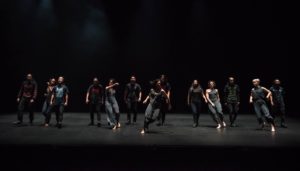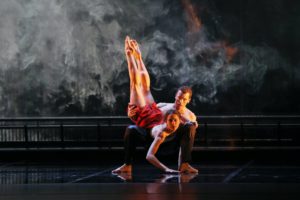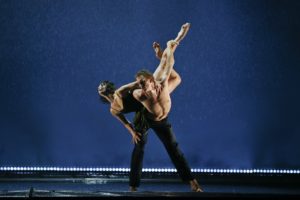Melbourne, February/March 2020 - Vancouver Ballet Society
- Home
- City Reports 2020 - 2023
- Melbourne, February/March 2020

By Rhys Ryan
Like most cities around the world right now, Melbourne’s theatres lie eerily dormant. Empty stages and foyers are just one troubling symptom of the unprecedented shutdown of an entire arts ecology. Strict social distancing measures were suddenly introduced in mid-March to slow the spread of COVID-19 in Australia, prematurely ending several performance seasons and cancelling all planned shows until, at least, mid-year.
It’s a far cry from the start of 2020, which was an exceptionally busy period in Melbourne’s dance calendar. A major international arts festival, Australia’s largest choreographic competition and a contemporary program from the national ballet company kept audiences entertained. Reflecting on these moments is bittersweet, a sobering reminder of the joy we derive from live performance.
The Asia-Pacific Triennial of Performing Arts (Asia TOPA) returned to Melbourne for its second iteration with a three-month multidisciplinary festival celebrating the work of contemporary artists across the Asia-Pacific region. Japan featured heavily in the dance program, together with several collaborations between Australian, Indonesian and Chinese artists.

Tokyo-based dancer-choreographer Ruri Mito presented her breathtaking solo Matou at Dancehouse in February. In Japanese, the title means both “to wear” and, figuratively, the moment your life flashes before your eyes in a near-death experience. Framed by this double entendre, the work explored the body as a mysterious and haunted vessel.
Prolonged sequences of extreme yogic twists and folds — each executed with astounding strength — cleverly obscured the geography of the dancer’s body. (Is that her shoulders or buttocks? How is the leg over there?) It was both animalistic and human, fleshy and alien. Mito’s decision to never reveal her face forced us to engage with the body impersonally, as a skin suspended between inner and outer forces.
Matou was a perfectly measured, transcendental study of the body. Sometimes glacial, sometimes violent, the highly articulate choreography was immaculately paced, hypnotizing the viewer with its corporeal distortions. Mito’s performance, defined by her exceptional technical capacity, helped cement this work as a festival highlight.
Asia TOPA also premiered Metal at Arts Centre Melbourne in February, an interesting, but slightly underdeveloped, cross-cultural collaboration between local choreographer Lucy Guerin and an Indonesian heavy metal choir. Five dancers and eight “metal heads” from Ensemble Tikoro shared the stage in a self-described “meeting of cultures, art forms, languages and belief systems.”
It was an admirable attempt at fusing forms. The singers’ guttural soundscapes both provoked and responded to the movement of the dancers, duel-like sequences erupting and dissolving from the smoky darkness. The choreography combined long clean lines with lasso-like arms, punctuating the heaving cries of the choir.

But the work never really achieved more than the presentation of two disparate mediums side-by-side. Late in the piece, when the choir disbanded and the imagery became more ambiguous, there was a hint of something more meaningful being created from the exchange. For the most part, though, the work adopted the rather conventional binary of East meets West.
While Asia TOPA played on, independent choreographers from all over Australia converged on Dancehouse for the fourth Keir Choreographic Award — the country’s biggest cash prize in the field. Eight artists were commissioned by an international jury to create a 20-minute choreographic performance, with the winner — also chosen by the jury — taking home AUD 50,000 (CAD 42,000).
This is no dance competition: The award seeks to illuminate the most urgent and experimental choreographic practices occurring in Australia today. The focus is on the art of choreography and the many different modes, aesthetics and perspectives it can embody. The result was a high-stakes omnibus of radically different works that evoked everything from tedium to wonder.

This year’s winner, Sydney-based Angela Goh, presented her compelling solo Sky Blue Mythic — an ambitious attempt to alienate dance from human expression. Like others in this year’s program, Goh returned to the fundamental elements of choreography — time, space and the body as a moving object — to find unorthodox modes of performance. Her minimalist approach relied heavily on material objects, like a sundial and fake diamond, together with looped movement to comment on consumerism, labour and theatricality. The work was both strangely efficient and totally compelling, securing Goh’s place in Australia’s choreographic landscape.
One of the last performances to premiere before the closure of theatres was Australian Ballet’s contemporary season, Volt, at Arts Centre Melbourne. It featured a new piece, Logos, by resident choreographer Alice Topp, in which the rising star returned to the human condition as her artistic muse.
Presenting the dancers as complex, thinking creatures not just gymnasts, Logos asked us to reflect on the inner demons we constantly manage, lest they overcome us. In a series of barefoot pas de deux, circling limbs, precarious balances and crumpling collapses told a story of the tenderness we afford ourselves and those around us.
Topp’s understanding of partnering is impressive, but the movement vocabulary and overall composition needed greater clarity to direct focus and sustain emotional tension. Jon Buswell’s design — featuring roving squares of light, a moving “painting” of billowing smoke and rainfall — was truly stunning, and impressed more than the dancing.

Logos was sandwiched between two Wayne McGregor works — the impossibly complex Chroma, whose unorthodox lifts and quick-fire sequences the dancers struggled to master, and Dyad 1929, a work made especially for Australian Ballet in 2009. The latter shared similarities with Chroma but differed in tone, offering a softness that allowed the dancers to stamp their personality across the choreography and rightly claim it as their own.
Unfortunately, Australian Ballet’s season was aborted after only three shows. It joined a growing list of cancelled or indefinitely postponed performances from independents through to major companies. The damage to Australia’s arts sector, especially small-to-medium organizations which suffered cruelly timed government funding cuts in the middle of the crisis, will no doubt continue well after the theatre doors reopen.

